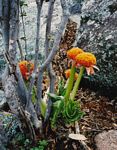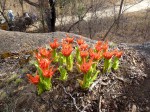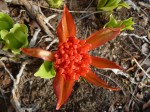| Home | > | List of families | > | Amaryllidaceae | > | Scadoxus | > | puniceus |
Scadoxus puniceus
Selected images: Click on each image to see a larger version and details of the record View all images (8)
Detailed records: Display species records QDS maps by: Google Maps Point records by Google Maps
Species details: Click on each item to see an explanation of that item (Note: opens a new window)
| Synonyms: |
Haemanthus puniceus L. |
| Common names: | Blood lily (English) Snake lily (English) |
| Frequency: | |
| Status: | Native |
| Description: |
Perennial herb, growing from a bulb, often suckering to form small colonies. Leaves in a basal rosette, developing with or after the flowers. Inflorescence not spherical, surrounded by large leaf-like bracts, longer than the flowers. Flowers with filiform segments, orange-red. Distinguished from S. multiflorus by the large bracts, the more flattened inflorescence and the orange-red colour of the flowers. |
| Type location: |
|
| Notes: | |
| Derivation of specific name: | puniceus: scarlet, carmine (though the flowers are actually often orange-red) |
| Habitat: | |
| Altitude range: (metres) | |
| Flowering time: | Oct - Dec |
| Worldwide distribution: | In Zimbabwe it is only recorded from the Matobo area but it is more common in parts of South Africa as well as in parts of Tanzania and Kenya. |
| National distribution: | SE |
| Growth form(s): | |
| Endemic status: | |
| Red data list status: | |
| Insects associated with this species: | |
| Spot characters: | Display spot characters for this species |
| Images last updated: | Wednesday 23 September 2015 |
| Literature: |
Bandeira, S., Bolnick, D. & Barbosa, F. (2007). Wild Flowers of Southern Mozambique Universidade Eduardo Mondlane, Maputo, Mozambique Page 67. (Includes a picture). Da Silva, M.C., Izidine, S. & Amude, A.B. (2004). A preliminary checklist of the vascular plants of Mozambique. Southern African Botanical Diversity Network Report No. 30 Sabonet, Pretoria Page 119. Golding, J.S. (ed.) (2002). Zimbabwe Plant Red Data List. Southern African Plant Red Data Lists. SABONET 14 Page 178. Kirby, G. (2013). Wild Flowers of Southeast Botswana Struik Nature, Cape Town South Africa Page 239. (Includes a picture). Mapaura, A. & Timberlake, J. (eds) (2004). A checklist of Zimbabwean vascular plants Southern African Botanical Diversity Network Report No. 33 Sabonet, Pretoria and Harare Page 85. Setshogo, M.P. (2005). Preliminary checklist of the plants of Botswana. Sabonet Report no. 37. Sabonet, Pretoria and Gaborone Page 113. Siebert, S. & Mössmer, M. (Editors) (2002). SABONET Southern Mozambique Expedition 2001; Provisional Plant Checklist of the Maputo Elephant Reserve (MER) and Licuati Forest Reserve (LFR) SABONET News 7(1) Page 23. Zimudzi, C., Archer, R.H., Kwembeya, E.G. & Nordal, I. (2008). Amaryllidacae Flora Zambesiaca 13(1) Pages 103 - 104. |
Other sources of information about Scadoxus puniceus:
Our websites:
Flora of Mozambique: Scadoxus puniceusFlora of Zimbabwe: Scadoxus puniceus
External websites:
African Plants: A Photo Guide (Senckenberg): Scadoxus puniceusBHL (Biodiversity Heritage Library): Scadoxus puniceus
EOL (Encyclopedia of Life): Scadoxus puniceus
GBIF (Global Biodiversity Information Facility): Scadoxus puniceus
Google: Web - Images - Scholar
iNaturalist: Scadoxus puniceus
IPNI (International Plant Names Index): Scadoxus puniceus
JSTOR Plant Science: Scadoxus puniceus
Mansfeld World Database of Agricultural and Horticultural Crops: Scadoxus puniceus
Plants of the World Online: Scadoxus puniceus
Tropicos: Scadoxus puniceus
Wikipedia: Scadoxus puniceus
| Home | > | List of families | > | Amaryllidaceae | > | Scadoxus | > | puniceus |




